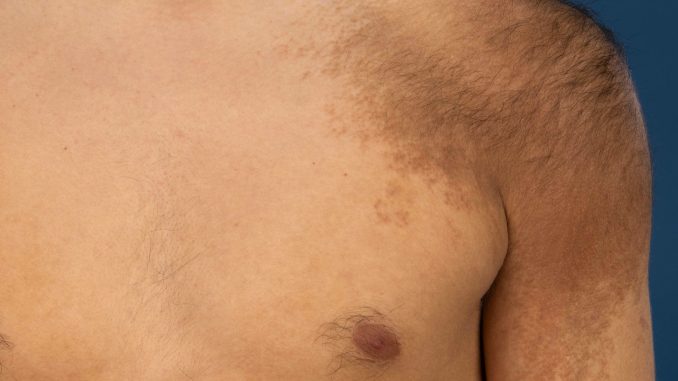
Becker’s Nevus Syndrome (BNS) is a rare condition that falls under the category of epidermal nevus syndromes. It is characterized by the presence of a Becker’s nevus, accompanied by breast hypoplasia or defects in the muscle, skin, or skeleton on the same side of the body.
Table of Contents
What is Becker’s nevus syndrome (BNS)?
Histologically, Becker’s nevus exhibits increased pigment in the basal cell layer of the epidermis, along with melanophages in the upper dermis. In some cases, there may be an increase in smooth muscle bundles in the dermis, similar to changes seen in congenital smooth muscle hamartomas.
Common symptoms of Becker’s Nevus include the development of an irregularly pigmented patch, which typically appears around puberty and is frequently found on the trunk and upper extremities. Hypertrichosis (excess hair growth) on the nevus and occasional acne formation are also observed.
The exact cause of Becker’s Nevus is not fully understood, but research indicates that it may be associated with genetic mutations. The condition appears to be androgen-dependent, as it becomes more pronounced after puberty. It is more commonly observed in men and tends to manifest with increased hairiness on the affected patch. Sun exposure may darken the lesions.
Becker’s Nevus may be associated with various tissue and skeletal abnormalities, including breast hypoplasia, extra nipples, spine and limb asymmetry, and other skeletal anomalies. Familial cases of Becker’s Nevus have also been reported.
According to Zion Market Research, The global Becker’s nevus market size was worth around USD 845.76 million in 2022 and is projected to grow to USD 1364.78 million by 2030 with a compound annual growth rate (CAGR) of roughly 6.17% between 2023 and 2030.
How Is Becker’s Nevus Diagnosed?
Diagnosis of Becker’s Nevus is usually based on the appearance of a brown, hairy, and deeply-pigmented patch, primarily on the shoulder or upper trunk. Treatment is often pursued for cosmetic reasons, and several options are available, including laser treatments for excess hair and hyperpigmentation.
Laser treatments, such as long-pulsed Alexandrite, Q-switched ruby, and Q-switched Nd:YAG, have shown varying success rates in treating hypertrichosis and hyperpigmentation. Fractional laser resurfacing can help with skin discoloration. Laser toning using non-ablative lasers is effective for milder pigmentation.
Other treatment options for excessive hair growth include laser hair removal, electrolysis, and shaving. Over-the-counter skin lightening creams are generally ineffective for managing Becker’s Nevus syndrome.
Since Becker’s Nevus is typically too large to be surgically removed, laser therapy and other treatments offer effective management options for the associated cosmetic concerns.
Becker’s Nevus Treatment Options: Laser or Plastic Surgery
When it comes to treating Becker’s Nevus, traditional surgical methods are not effective and may result in unsatisfactory outcomes or noticeable scarring. While plastic surgery might improve the appearance of the patches in some cases, it is not always successful. On the other hand, laser therapy is widely regarded as a more effective and safer alternative to surgical procedures.
Laser technology offers a promising clinical solution for reducing both hyperpigmentation and hypertrichosis associated with Becker’s Nevus. Laser treatments have shown to bring about improvements in the cosmetic appearance of the nevus lesions, making them a preferred choice for managing this condition.

Leave a Reply